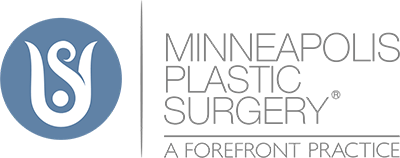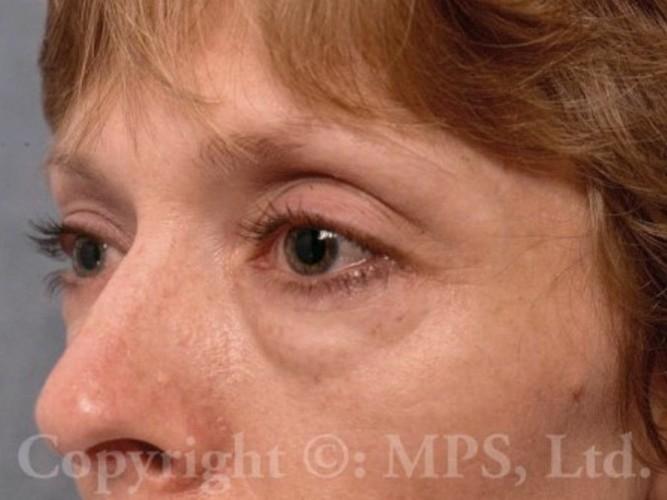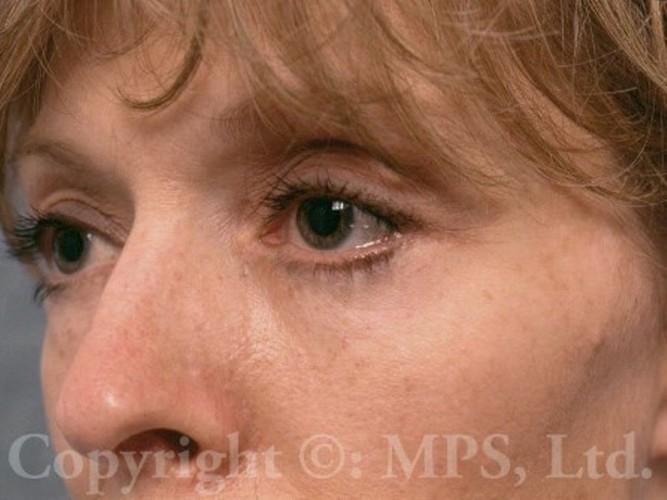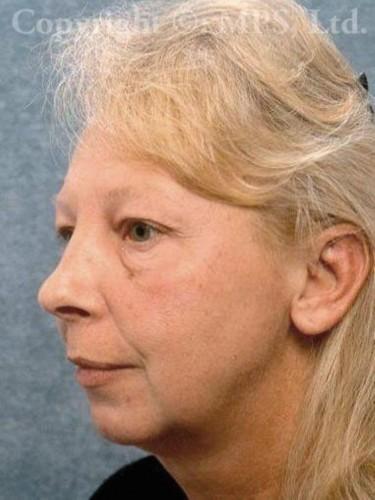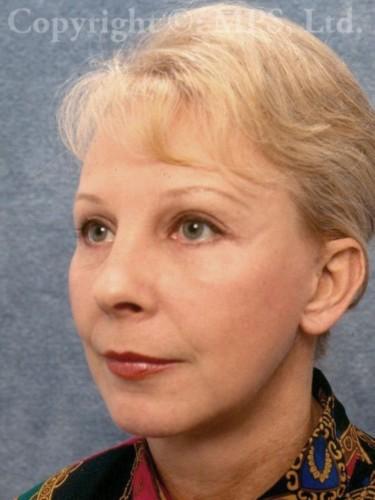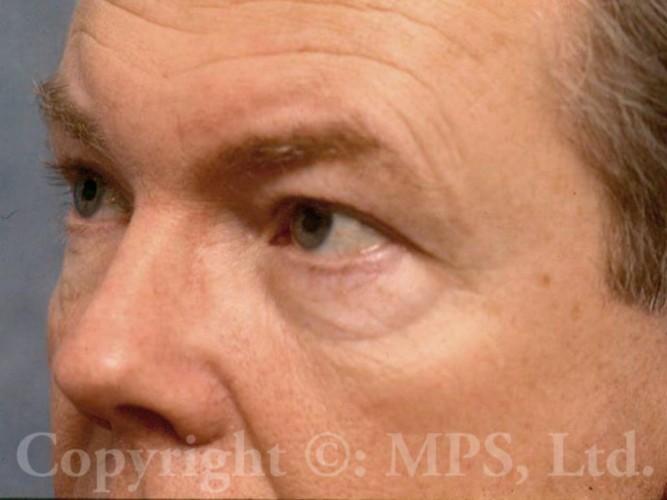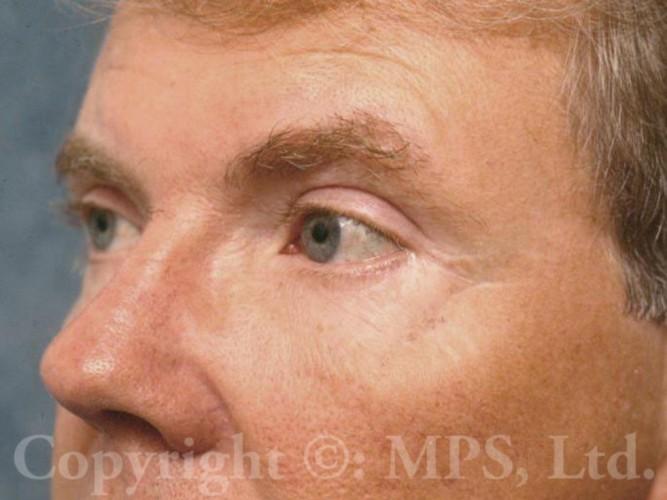Blepharoplasty (Eyelid Surgery) and Brow Lift (Forehead Lift) Surgery
Eyelid surgery and brow lift surgery can enhance your appearance and your self-confidence by eliminating the drooping, sagging, and protrusion in the upper and lower eyelid and brow areas that can create a tired or angry look. These outpatient procedures are frequently performed in our nationally-accredited (QUAD A, formerly AAAASF) in-office surgical facility at Minneapolis Plastic Surgery, LTD. With lower lid blepharoplasty (lower eyelid surgery), loose, wrinkled, or sagging skin and protruding fat pads under the eyes can be corrected. Dark circles can also be improved by eliminating the shadowing caused by the fat and loose eyelid skin.
Who is a Good Candidate for Brow Lift or Eyelid Lift?
Loose skin and hooding of the upper eyelid areas may be correctable via upper eyelid blepharoplasty alone, or may require brow lift (or both). If the brows are at or below the upper orbital rim (the bony edge of the skull), what appears to be upper eyelid skin excess may actually be brow ptosis (droop) causing this appearance, or a combination of true upper eyelid skin excess and brow ptosis. Performing upper lid blepharoplasty alone in the setting of brow ptosis may sculpt or refine the upper eyelid areas, but will pull the brows even lower, making an angry, tired, pensive, or brooding appearance even worse.
These patients will benefit most from a brow lift (or forehead lift), which can raise the brows to their proper position just above the bony rim (for women) or just at the bony rim (in men), giving a more awake or refreshed look. The incision is hidden in the hair (which is not shaved or clipped), making the scar totally invisible, even as it heals. An alternative incision for men (or women who have a higher hairline) is made near the scalp-forehead hairline, raising the brows as anticipated, but also lowering the anterior hairline! Though this incision is visible initially, beveling the incision, making the incision wavy rather than a straight line, and performing meticulous two-layer closure allows this scar to have hair grow through it, making it progressively less visible as it heals and matures. Even bald males undergoing forehead lift (brow lift) via this incision usually find the scar scarcely visible when healed and matured.
Frown muscles can also be surgically reduced at the time of brow lift, minimizing the vertical “worry lines” between the brows. These are the same 1, 11, or 111 frown lines treated with Botox Cosmetic® injections. Thus, for patients who request these frown lines be surgically treated at the time of brow lift surgery, further Botox treatment of these line is either eliminated or substantially reduced. After brow lift surgery, any remaining true upper eyelid skin excess and protruding fat pads can be addressed via upper lid blepharoplasty, at the time of brow lift surgery, or separately. All three procedures are commonly performed together where necessary, and can be combined with face lift or other surgery if desired.
Endoscopic brow lifts started to become popular at the same time endoscopic appendectomies and other laparoscopic surgeries became popular in the 1980’s and 1990’s. Though both American Board of Plastic Surgery-certified plastic surgeons at Minneapolis Plastic Surgery, LTD. have trained with endoscopic procedures, we have found that a precisely-closed and totally hidden bicoronal (across the top of the head; hair not shaved) incision heals as well (and often less visibly) than the 3 or 4 hairline incisions needed for endoscopic procedures, and allows better treatment of the brow at the upper orbital rims, reduction of the frown muscles normally treated with Botox, and any bony smoothing when requested. These are not as easily performed through an endoscope, which also costs more, and takes more time (or are skipped altogether). Though good results can be obtained via endoscopic forehead (brow) lift, we have found that better results can be achieved with a bicoronal incision operation that takes less time and instrumentation, not to mention with lower total cost.
Eyelid Surgery (Blepharoplasty)
As people age, upper and lower eyelid skin stretches and muscles weaken, allowing normal fat around the eyes to protrude, causing “bags” and loose folds of excess skin and wrinkles to appear. To explain this another way, eye “bags” are not caused by excess fat, but by the same normal amounts of fat always present since youth that now protrude through weakened orbital septal tissues, and skin and muscles that have decreased tone and elasticity, as well as increased stretch or sag. Lid position can also change.
Forehead and brow tissues can also loosen and sag, causing the brows to droop below the orbital rim, contributing to true upper eyelid skin excess, and giving a hooded, tired, angry, pensive, or “drawn” appearance. During your consultation, one of the plastic surgeons at Minneapolis Plastic Surgery, LTD. can assess which areas require surgery. The best candidates for blepharoplasty and/or brow lift are men and women who are physically healthy, psychologically stable, and realistic in their expectations. Generally patients for this procedure are 35 years or older. However, sagging eyelids or prominent fat pads can be a genetic trait in some families, making eyelid surgery beneficial at a younger age.
Eyelid surgery can be performed under general anesthesia, local anesthesia plus sedation, or local anesthesia. During your consultation, you can discuss these options with your plastic surgeon. Blepharoplasty surgery takes one or two hours, depending on whether two or all four eyelids are to be treated. If brow lift is necessary, this requires an hour or longer depending on hairline and incision placement choices. Brow lift surgery usually requires general anesthesia.
Eyelid surgery under local anesthesia with intravenous sedation (“twilight anesthesia”), or general anesthesia require the care and monitoring of our talented CRNA anesthesia staff, so costs are similar for both anesthesia options. It has been our experience that “twilight anesthesia” is typically offered and touted as “superior” than general anesthesia by those surgeons and practices that do not have the capability to offer all anesthesia options, including experience with TIVA (Total IV Anesthesia). With TIVA, which we utilize in virtually all general anesthesia cases at Minneapolis Plastic Surgery, LTD., patients wake up just as rapidly, easily, and without nausea and vomiting as twilight anesthesia, but without the potential for inadvertent “waking-up” or half-asleep twitching or movement that can occur during sedation (twilight) anesthesia. TIVA provides complete avoidance of any movement (important when operating so close to the eyes), and also avoids the longer wake-up and even higher rates of post-op nausea and vomiting (PONV) frequently associated with “regular” inhalation general anesthesia.
With lower lid blepharoplasty, the lid skin and muscle are tightened and the fat pads trimmed and/or repositioned. The incisions made during lower eyelid surgery are just below the eyelashes, and leave a scar that is nearly imperceptible. Lower lid position can be elevated if necessary or desirable, and may help to avoid scar tissue pulling the lower lid out of its desired final position.
For upper eyelid blepharoplasty, the incision is made in the natural eyelid crease, and also leaves a nearly imperceptible scar in most cases. Accurate measurement of the true upper eyelid skin excess is made by our surgeons in the preoperative area before anesthesia or sedation is received, maximizing the cosmetic result after healing, and minimizing dry eyes or lid malposition causing an abnormal or “staring” appearance. Some swelling and bruising is present in every eyelid surgery patient, and this usually resolves within two weeks or so. You will be given instructions on what to do to reduce bruising and enhance healing so you may return to work and social activities promptly.
Lack of upper eyelid folds or presence of epicanthal folds is a common genetic trait in many Asian races, and can be seen in other races as well. Our American Board of Plastic Surgery-certified plastic surgeons are experienced in the specialized blepharoplasty techniques required to successfully refine these characteristics as desired.
Brow lift may be necessary in either men or women with brows that are at or below the orbital rim, contributing to “apparent” upper eyelid skin excess or hooding. Consultation with our plastic surgeons will allow you to find out if this is recommended for your best result. If upper eyelid surgery is performed instead of brow lift (when brow lift is recommended), the upper eyelids may be smoother and sculpted, but the brow position can drop even more, adding to the hooded, brooding, tired, or pensive appearance for which eyelid surgery was considered initially.
After surgery, patients may feel tightness around their eyes. Lubricating ointment is used in the eyes immediately after surgery, and will be continued at night until the lids close completely as swelling diminishes. Ice bags to the protected skin (frozen peas over a dry cloth works well) and elevation of the head while sleeping will help keep swelling and bruising down. Do not use moist compresses, as the incisions absorb water and swell more. For the first few weeks following blepharoplasty surgery, patients may experience increased tearing, sensitivity to light, and temporary changes in vision such as blurring. Patients will return to Minneapolis Plastic Surgery, LTD. about one week after eyelid surgery to have upper eyelid sutures removed, and ten days or so for brow lift patients. Lower eyelid sutures are dissolving and do not require removal. If you note bleeding or vision change after eyelid surgery, contact us immediately at 763-545-0443 or call 911.
Most patients resume social activities about two weeks after brow lift and/or eyelid surgery, though daily activities resume within a few days after surgery. Strenuous activities and exercise must be avoided for two to three weeks after surgery. Patients in certain occupations, such as TV personality, actor, or those in close personal contact with their co-workers or clients may prefer to wait slightly longer to return to work.
As with any surgical procedure, complications are possible, though unlikely. Bleeding around the eyes is potentially more serious than in other areas, as pressure on the retina or optic nerves can cause vision change or blindness. For this reason, it is imperative that you avoid aspirin or ibuprofen-containing medications for two weeks before and after surgery. Head elevation and avoidance of strenuous activity or exercise is necessary for two to three weeks after surgery, and bending over or lifting objects heavier than 5 pounds is forbidden. Other extremely rare complications can include infection or a reaction to the anesthesia used. Minor complications seen with eyelid or brow surgery can include minor vision change or blurring, which is caused by swelling of the cornea. This generally resolves as bruising and swelling settle, allowing the eyelids to lubricate the eye more completely. After surgery you should use the provided eye lubricant at night, as some patients may have swelling causing difficulty closing their eyes when they sleep. During the day, artificial tears should be used as needed until swelling resolves and the lids close normally. Since swelling/bruising is different in each patient, and also in each eye, it is normal to note slight asymmetry in healing or scarring. This usually resolves over time. Adhering to your surgeon’s instructions regarding pre- and post-operative care will greatly reduce the risk of complications.
Brow Lift Surgery
A brow lift, or forehead lift, is a surgical procedure designed to elevate drooping eyebrows and minimize the frown lines and forehead creasing that sometimes results over the years as people make normal facial expressions. Forehead creasing and frown lines are minimized in the brow lift procedure, but this treatment is predominantly recommended for patients who can benefit from repositioning of the eyebrows. A low or sagging brow caused by aging can make the eyelids appear hooded; for this reason many patients who come to our Minneapolis, Minnesota office thinking they need upper blepharoplasty (eyelid) surgery are actually better candidates for brow lift surgery, or a combination of both surgeries.
Brow lift may be necessary in both men and women with brows that are positioned at or below the orbital rim, contributing to “apparent” upper eyelid skin excess or hooding. Normally, the incision for brow lift or forehead lift is hidden entirely within the hair an inch or two behind the hairline, making the final scar well-concealed and usually invisible within the hair. In some patients with high foreheads or receding hairlines, a better incision choice is just at the hairline, which can actually lower the hairline or reduce forehead height. Hairline incisions require more time and surgical skill and precision, but can yield improved cosmetic results in those patients who require this, such as men or women with thinning hair or high hairlines. Beveling the incision and making it wavy rather than straight can allow hair growth through the skin in front of the actual incision and scar, which help to camouflage and hide it, especially as the scar goes through the natural fading and maturation process.
At the time of brow lift, tiny forehead frown muscles between the brows can be surgically treated, reducing the “furrows” or worry lines between the eyebrows, which provides an effect similar to “permanent Botox.” With brow lift procedures the hair is not shaved or clipped, and a head bandage and tiny surgical drain is present for one or two days, after which it is removed and a hair wash and blow dry performed at our clinic. Bruising and swelling is similar to that seen with eyelid surgery, and generally resolves in about two weeks. As noted above, brow lift surgery usually require general (TIVA) anesthesia.
After surgery, patients will receive instructions from their plastic surgeon that should be carefully followed for the best cosmetic result. It is important to keep the head elevated to reduce swelling and speed healing. One or two days after brow lift surgery, your bandages can be removed, but it is likely that there will still be some numbness and light swelling. Most patients can return to (non-strenuous) work seven to 10 days after surgery; however, it is important to keep in mind that every patient’s recovery is unique.
Cost for Blepharoplasty (Eyelid Surgery or Eyelid Lift) and Brow Lift (Forehead Lift)
Total cost for upper eyelid lift (upper blepharoplasty) is around $ 6600. This includes no-charge consultation, professional (surgeon’s) fee, complete anesthesia fees, operating room, and all post-operative follow-up visits. Cost for lower lid blepharoplasty (lower lid lift) is around $ 7000. Total cost for both upper and lower lid blepharoplasty (4-lid lift) at one operation is around $ 8700. Total cost for brow lift (forehead lift) alone is around $8500; hairline forehead lifts start at $10000, and forehead lift plus bony contouring is $9500 or more. Costs for combination brow lift and lower eyelids, brow lift and upper eyelids, and brow lift and all four eyelids (upper and lower blepharoplasty plus forehead lift) are available at the time of complimentary consultation for those patients who request these options. Financing options are available.
Because of the high demand for free consultations with our plastic surgeons, our staff will ask for a credit card number in order to schedule a consultation; there is no charge whatsoever for appointments that are kept–you will be charged $100 only if you fail to keep a scheduled appointment, or fail to cancel at least 48 hours in advance of your appointment time–for Monday appointments, you must cancel no later than noon on the previous Thursday; for Tuesday appointments, you must cancel by noon on the previous Friday.
For more information about eyelid or forehead (brow) lift surgery, please contact us for a no-obligation consultation with our ABPS-certified plastic surgeons.
